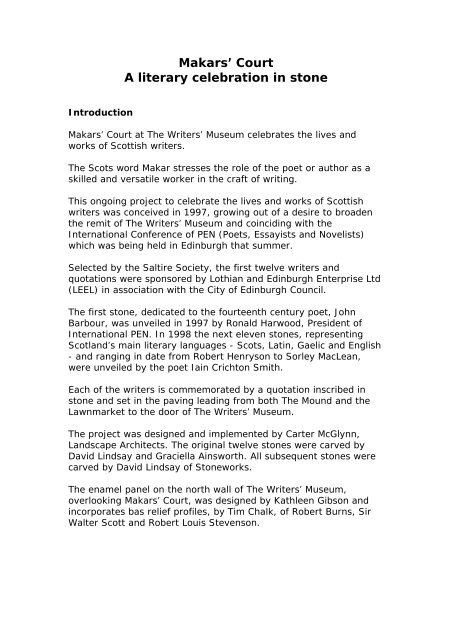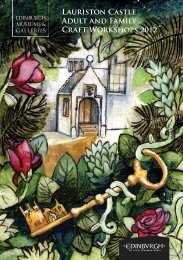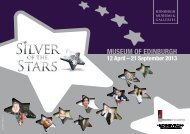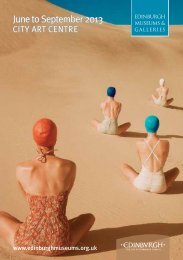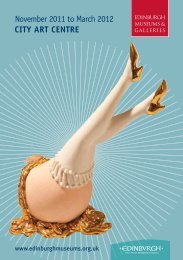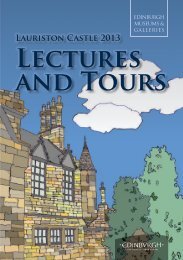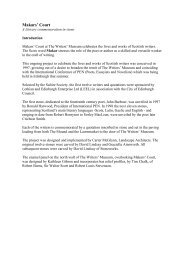More on Makars' Court - Edinburgh Museums
More on Makars' Court - Edinburgh Museums
More on Makars' Court - Edinburgh Museums
Create successful ePaper yourself
Turn your PDF publications into a flip-book with our unique Google optimized e-Paper software.
Makars’ <strong>Court</strong><br />
A literary celebrati<strong>on</strong> in st<strong>on</strong>e<br />
Introducti<strong>on</strong><br />
Makars’ <strong>Court</strong> at The Writers’ Museum celebrates the lives and<br />
works of Scottish writers.<br />
The Scots word Makar stresses the role of the poet or author as a<br />
skilled and versatile worker in the craft of writing.<br />
This <strong>on</strong>going project to celebrate the lives and works of Scottish<br />
writers was c<strong>on</strong>ceived in 1997, growing out of a desire to broaden<br />
the remit of The Writers’ Museum and coinciding with the<br />
Internati<strong>on</strong>al C<strong>on</strong>ference of PEN (Poets, Essayists and Novelists)<br />
which was being held in <strong>Edinburgh</strong> that summer.<br />
Selected by the Saltire Society, the first twelve writers and<br />
quotati<strong>on</strong>s were sp<strong>on</strong>sored by Lothian and <strong>Edinburgh</strong> Enterprise Ltd<br />
(LEEL) in associati<strong>on</strong> with the City of <strong>Edinburgh</strong> Council.<br />
The first st<strong>on</strong>e, dedicated to the fourteenth century poet, John<br />
Barbour, was unveiled in 1997 by R<strong>on</strong>ald Harwood, President of<br />
Internati<strong>on</strong>al PEN. In 1998 the next eleven st<strong>on</strong>es, representing<br />
Scotland’s main literary languages - Scots, Latin, Gaelic and English<br />
- and ranging in date from Robert Henrys<strong>on</strong> to Sorley MacLean,<br />
were unveiled by the poet Iain Cricht<strong>on</strong> Smith.<br />
Each of the writers is commemorated by a quotati<strong>on</strong> inscribed in<br />
st<strong>on</strong>e and set in the paving leading from both The Mound and the<br />
Lawnmarket to the door of The Writers’ Museum.<br />
The project was designed and implemented by Carter McGlynn,<br />
Landscape Architects. The original twelve st<strong>on</strong>es were carved by<br />
David Lindsay and Graciella Ainsworth. All subsequent st<strong>on</strong>es were<br />
carved by David Lindsay of St<strong>on</strong>eworks.<br />
The enamel panel <strong>on</strong> the north wall of The Writers’ Museum,<br />
overlooking Makars’ <strong>Court</strong>, was designed by Kathleen Gibs<strong>on</strong> and<br />
incorporates bas relief profiles, by Tim Chalk, of Robert Burns, Sir<br />
Walter Scott and Robert Louis Stevens<strong>on</strong>.
The Makars<br />
There follows brief biographical details <strong>on</strong> the writers, setting the<br />
quotati<strong>on</strong>s in c<strong>on</strong>text. Where l<strong>on</strong>ger passages are cited, the words<br />
inscribed <strong>on</strong> the st<strong>on</strong>es are underlined. Details of sp<strong>on</strong>sors are<br />
given for those writers commemorated since 1998.<br />
John Barbour (c.1320-1395)<br />
Clerk and auditor to the Exchequer of King Robert II, Barbour, "the<br />
father of Scottish literature", is best-known for his epic poem, The<br />
Bruce. Written in 1375, it is the earliest- surviving major poem<br />
written in Scots and deals with the Wars of Independence, and the<br />
Battle of Bannockburn in 1314:<br />
A! Fredome is a noble thing,<br />
Fredome mays man to haiff liking,<br />
Fredome all solace to man griffis,<br />
He levys at es that frely levys.<br />
Lachlan Mor MacMhuirich (c1370 - 1438)<br />
A Chlanna Cuinn cuimhnichibh<br />
Cruas an àm na h-iorghaile<br />
(Translati<strong>on</strong>: O Children of C<strong>on</strong>n, remember<br />
Hardihood in time of battle.)<br />
[from the first verse of his poem the Harlaw Brosnachadh<br />
(Incitement to Battle) written in Scots Gaelic, 1411]<br />
Lachlan Mór MacMhuirich was a member of Scotland's l<strong>on</strong>gest lived<br />
bardic dynasty, the MacMhuirich's. The MacMhuirichs (later<br />
anglicised to "Currie") served for over 700 years as professi<strong>on</strong>al<br />
poets to the Lords of the Isles and later to the MacD<strong>on</strong>alds of<br />
Clanranald am<strong>on</strong>g other prominent Highland clans and families. The<br />
Red Book of Clanranald, <strong>on</strong>e of Gaelic Scotland’s literary treasures,<br />
was penned by successive generati<strong>on</strong>s of the MacMhuirich family.
Lachlan Mór MacMhuirich’s, Harlaw Brosnachadh, or Incitement to<br />
Battle was delivered by MacMhuirich <strong>on</strong> the eve of the Battle of Red<br />
Harlaw <strong>on</strong> July 24, 1411 to inspire the army of the Lord of the Isles<br />
to victory in the following day's battle. This battle, <strong>on</strong>e of the<br />
fiercest ever fought <strong>on</strong> Scottish soil, was occasi<strong>on</strong>ed by the claim of<br />
D<strong>on</strong>ald, Lord of the Isles, to the earldom of Ross: a claim vigorously<br />
c<strong>on</strong>tested by the Earl of Mar, whose uncle the Duke of Albany,<br />
brother of the late Robert III, was ruling as regent for the<br />
impris<strong>on</strong>ed James I.<br />
The poem begins ‘Children of C<strong>on</strong>n, remember hardihood in time of<br />
battle’ - addressing Clan D<strong>on</strong>ald with reference to their putative<br />
descent from C<strong>on</strong>n of the Hundred Battles, a heroic king of Irish<br />
traditi<strong>on</strong>.<br />
Sp<strong>on</strong>sored by the Clan Currie Society, Inc.<br />
Robert Henrys<strong>on</strong> (c.1425 - c.l490)<br />
A schoolmaster in Dunfermline and <strong>on</strong>e of Scotland’s greatest<br />
poets, Henrys<strong>on</strong>’s best-known works are the narrative poem, The<br />
Testament of Cresseid, and the collecti<strong>on</strong> of allegorical tales, The<br />
Moral Fabillis, which are largely based <strong>on</strong> the fables of Aesop. The<br />
Two Mice is the story of the town mouse and the country mouse:<br />
Blissed be sempill lyfe withoutin dreid;<br />
Blissed be sober feist in quietie.<br />
Quha hes aneuch, of na mair hes he neid,<br />
Thocht it be littill into quantatie.<br />
William Dunbar (c.1460 - c.1520)<br />
A poet in the brilliant Renaissance <strong>Court</strong> of King James IV, Dunbar<br />
was a most accomplished and versatile craftsman in his mastery of<br />
words and metres. His Lament for the Makars, is a lament for his<br />
brother poets who have died; the works of many of them have since<br />
disappeared:<br />
Our plesance here is all vane glory,<br />
This fals warld is bot transitory,<br />
The fesche is brukle, the Feynd is sle;<br />
Timor Mortis c<strong>on</strong>turbat me.
Sir David Lyndsay (c. 1486 – 1555)<br />
Lat us haif the bukis necessare<br />
To commoun weill<br />
(Translati<strong>on</strong>: Let us have the books necessary<br />
To our comm<strong>on</strong> good)<br />
[from Ane Dialog betuix Experience and Ane <strong>Court</strong>eour, lines 678-<br />
79, first printed 1554]<br />
The s<strong>on</strong> of a Fife landholder, David Lyndsay (c. 1486–1555) became<br />
a celebrated poet and herald. Lyndsay was promoted master usher<br />
to the infant James V in 1513, after James IV’s death at Flodden,<br />
and for the next decade was the king’s much-loved compani<strong>on</strong>. The<br />
minority’s end brought brief loss of favour, but Lyndsay’s wife,<br />
Janet Douglas, c<strong>on</strong>tinued as royal seamstress and by 1530 Lyndsay<br />
was a herald. In this key role he traveled extensively <strong>on</strong> the king’s<br />
business, devised Scotland’s public pageantry and compiled the first<br />
native armorial. He also wrote vivid poems for king and court,<br />
including The Dreme and The Testament of the Papyngo. By 1542<br />
he had been knighted and appointed chief herald, the Ly<strong>on</strong> King of<br />
Arms. In Mary’s minority Sir David c<strong>on</strong>tinued to combine his<br />
heraldic and literary activities, writing The Tragedie of the Cardinall,<br />
Squyer Meldrum, the theatrical masterpiece, Ane Satyre of the Thrie<br />
Estaitis, and the enormously popular Ane Dialog betuix Experience<br />
and ane <strong>Court</strong>eour. Although he wrote before the Reformati<strong>on</strong> of<br />
the Scottish kirk, Lyndsay’s eloquent commitment to educati<strong>on</strong> and<br />
to social and religious reform ensured that his influence c<strong>on</strong>tinued<br />
l<strong>on</strong>g after his death.<br />
Sp<strong>on</strong>sored by The Sir David Lyndsay Society<br />
George Buchanan (1506 - 1582)<br />
Born in Killean, Stirlingshire, Buchanan is the greatest of the<br />
Scottish Latinists, a court poet and, later, tutor to the young King<br />
James VI. He is famous for his Latin poems, drama, a history of<br />
Scotland, and political treatises which include De lure Regni apud<br />
Scottos (The Law of Sovereignty am<strong>on</strong>g the Scots):<br />
Populo enim jus est ut imperium cui velit deferat<br />
[For it is right that the people c<strong>on</strong>fer power <strong>on</strong> whom they please]
James Boswell (1740 - 1795)<br />
I rattled down the High Street in high elevati<strong>on</strong> of spirits.<br />
[from Journal, 15 November 1762]<br />
James Boswell, biographer and diarist, was born in <strong>Edinburgh</strong> <strong>on</strong> 29<br />
October 1740. The author of the most popular biography in the<br />
English language, The Life of Samuel Johns<strong>on</strong> (1791), Boswell<br />
arguably invented modern literary biography. In a unique, dramatic<br />
style, he represented the wise and witty c<strong>on</strong>versati<strong>on</strong> of Johns<strong>on</strong><br />
(1709-1784), the great English lexicographer and author. Boswell<br />
also wrote a successful Account of Corsica in 1768 and the<br />
acclaimed Journal of a Tour to the Hebrides in 1785, al<strong>on</strong>g with<br />
numerous shorter works.<br />
The discovery and subsequent publicati<strong>on</strong> of Boswell's journals and<br />
other private papers in the early 20th century changed the nature<br />
of his literary fame. Few writers revealed their thoughts and<br />
recorded their acti<strong>on</strong>s in such h<strong>on</strong>est and engaging detail. Boswell's<br />
L<strong>on</strong>d<strong>on</strong> Journal of 1762-63, first published in 1950, became a<br />
worldwide bestseller.<br />
Boswell lived in <strong>Edinburgh</strong>, where he worked as a lawyer, and in<br />
Ayrshire at his family estate, Auchinleck. He married his cousin<br />
Margaret M<strong>on</strong>tgomerie in 1769 and produced five children. The<br />
eldest, Alexander, became an accomplished poet and James Jr. an<br />
editor of Shakespeare. James Boswell died in L<strong>on</strong>d<strong>on</strong> <strong>on</strong> 19 May<br />
1795, at the age of 54.<br />
Sp<strong>on</strong>sored by the Boswell Museum and Mausoleum Trust<br />
Robert Ferguss<strong>on</strong> (1750 - 1774)<br />
Born in <strong>Edinburgh</strong>, Ferguss<strong>on</strong>’s work has had c<strong>on</strong>siderable influence<br />
<strong>on</strong> later writers, including Burns, Stevens<strong>on</strong> and Garioch. His poems<br />
in Scots c<strong>on</strong>tain detailed descripti<strong>on</strong>s of daily life in late 18th<br />
century <strong>Edinburgh</strong> (known as Auld Reikie or Old Smoky):<br />
Auld Reikie, wale o ilka town<br />
That Scotland kens beneath the mo<strong>on</strong>;<br />
Where couthy chiels at e `ening meet<br />
Their bizzing craigs and mous to weet;<br />
And blythlv gar auld care gae bye<br />
Wi blinket and wi bleering eye
Robert Burns (1759 - 1796)<br />
Born <strong>on</strong> 25 January 1759 at Alloway, Ayrshire, Burns is celebrated<br />
the world over as Scotland’s nati<strong>on</strong>al poet. His collecti<strong>on</strong> of poems,<br />
Chiefly in the Scottish Dialect, published at Kilmarnock in 1786, was<br />
followed by s<strong>on</strong>gs and poems of enduring popularity; <strong>on</strong>e of the<br />
best-known, Is there for h<strong>on</strong>est poverty, ends with the lines:<br />
Then let us pray that come it may<br />
(As come it will for a' that)<br />
That Sense and Worth o'er a' the earth<br />
Shall bear the gree an' a' that!<br />
For a' that, an' a' that,<br />
It's comin yet for a' that,<br />
That man to man the world o'er<br />
Shall brithers be for a' that.<br />
Sir Walter Scott (1771 - 1832)<br />
Born in <strong>Edinburgh</strong>, and educated at the High School and University,<br />
Scott was an advocate and Clerk of the <strong>Court</strong> of Sessi<strong>on</strong> and a<br />
writer of prodigious output. Few, if any, other writers have gained<br />
such prestige and influence, nati<strong>on</strong>ally and internati<strong>on</strong>ally, by their<br />
writing al<strong>on</strong>e. His early reputati<strong>on</strong> was as a narrative poet, including<br />
The Lay of the Last Minstrel (1805) from which the following<br />
quotati<strong>on</strong> is taken:<br />
Breathes there the man, with soul so dead,<br />
Who never to himself hath said,<br />
This is my own, my native land!<br />
Scott then turned to a series of historical novels which were not<br />
<strong>on</strong>ly an important influence <strong>on</strong> literature, painting and music in<br />
many countries, but changed attitudes towards the past. The first<br />
was Waverley (1814), which gave its name to the whole series, and<br />
the others include Old Mortality, Rob Roy, The Heart of Midlothian<br />
and Redgauntlet.
John Galt (1779 - 1839)<br />
John Galt was born in Irvine, Ayrshire, <strong>on</strong> 2 May 1779 and his<br />
family moved to Greenock when he was ten. He travelled widely,<br />
living in Canada for two years, and wrote plays, poetry and<br />
biography before turning his attenti<strong>on</strong> to novels. Annals of the<br />
Parish (1821), like many of Galt’s novels, is set in the west of<br />
Scotland and is a lively and entertaining account of life and social<br />
change narrated in the first pers<strong>on</strong>:<br />
..he published at <strong>Edinburgh</strong> a volume of Moral Essays, of which he<br />
sent me a pretty bound copy and they were greatly creditable to his<br />
pen, though lacking somewhat of that birr and smeddum that is the<br />
juice and flavour of books of that sort.<br />
Galt returned to Greenock in 1834 and c<strong>on</strong>tinued to write short<br />
stories until his death <strong>on</strong> 11 April 1839.<br />
Sp<strong>on</strong>sored by The Saltire Society, 2002.<br />
Robert Louis Stevens<strong>on</strong> (1850 - 1894)<br />
Born in <strong>Edinburgh</strong> <strong>on</strong> 13 November 1850, Stevens<strong>on</strong> spent most of<br />
his life travelling in search of good health, finally settling in Samoa<br />
(1890), where he died <strong>on</strong> 3 December 1894. His principal novels<br />
are Treasure Island (1883), The Strange Case of Dr Jekyll and Mr<br />
Hyde and Kidnapped (1886). He also wrote poems, and essays<br />
including The Scot Abroad from The Silverado Squatters (1883):<br />
no society of the wise and good, can repay me for my absence<br />
from my country. And though I think I would rather die elsewhere,<br />
yet in my heart of hearts I l<strong>on</strong>g to be buried am<strong>on</strong>g good Scots<br />
clods. I will say it fairly, it grows <strong>on</strong> me with every year: there are<br />
no stars so lovely as <strong>Edinburgh</strong> street-lamps. When I forget thee,<br />
Auld Reekie, may my right hand forget its cunning!
Violet Jacob (1863 - 1946)<br />
Born Violet Kennedy-Erskine, a daughter of the 18th Laird of Dun,<br />
she grew up at the family home, House of Dun, near M<strong>on</strong>trose in<br />
Angus. ln 1894 she married Arthur Jacob, an army officer, and<br />
travelled widely. She wrote an historical novel, Flemingt<strong>on</strong> (1911),<br />
other novels, short stories, books for children and travel diaries, but<br />
she is best known for her poetry, written in good, natural Scots. It<br />
often shows a l<strong>on</strong>ging for her home country, as in The Wild Geese:<br />
But saw ye naethin, leein Wind, afore ye cam to Fyfe?<br />
There’s muckle lyin y<strong>on</strong>t the Tay that’s mair to me nor life<br />
My man, I swept the Angus braes ye haena trod for years<br />
O Wind forgie a nameless lo<strong>on</strong> that canna see for tears.<br />
Neil Munro (1863 - 1930)<br />
Born in Inveraray <strong>on</strong> 3 June 1863, Munro followed a career in<br />
journalism, becoming assistant editor of the Glasgow Evening News.<br />
He published many articles, novels and short stories, including the<br />
popular series chr<strong>on</strong>icling the adventures of Para Handy and the<br />
crew of the West Highland coaster ‘Vital Spark’, a humorous social<br />
commentary <strong>on</strong> c<strong>on</strong>temporary events. The c<strong>on</strong>stant theme of<br />
Munro’s work is the impact, for good and ill, of social change <strong>on</strong> the<br />
Highlands, found most notably in his novel The New Road (1914):<br />
It means the end of many things, I doubt not all to be despised, -<br />
the last stand of Scotland, and she destroyed. And yet, and yet, this<br />
New Road will some day be the Old Road, too, with ghosts <strong>on</strong> it and<br />
memories.<br />
Munro died <strong>on</strong> 22 December 1930 and was buried in Kilmalieu<br />
Cemetery, Inveraray.<br />
Sp<strong>on</strong>sored by the Cromarty Arts Trust, 2002.
John Buchan (1875 - 1940)<br />
We can <strong>on</strong>ly repay our debt to the past by putting the future in debt<br />
to us.<br />
[from an Address to the people of Canada <strong>on</strong> the Cor<strong>on</strong>ati<strong>on</strong> of<br />
George VI, 12 May 1937]<br />
Born <strong>on</strong> 26 August 1875 in Perth, Buchan was greatly influenced by<br />
his predecessors Scott and Stevens<strong>on</strong>, finding a rich source of<br />
literary material in Scotland’s history and landscape. He wrote more<br />
than 100 books, which included novels, biographies, histories, short<br />
stories and verse, including The Thirty Nine Steps (1915). Also a<br />
politician, he crowned his career as Bar<strong>on</strong> Tweedsmuir, Governor-<br />
General of Canada (1935-1940) and Chancellor of <strong>Edinburgh</strong><br />
University. He died in Canada <strong>on</strong> 11 February 1940.<br />
Sp<strong>on</strong>sored by the John Buchan Society, 2001.<br />
Helen Cruickshank (1886-1975)<br />
Helen Burness Cruickshank was born and educated in Angus, before<br />
joining the Civil Service and working first in L<strong>on</strong>d<strong>on</strong> and then, from<br />
1912, in <strong>Edinburgh</strong>, where she lived until her death. Best known as<br />
a poet, she was also a cultural and political activist, and a close<br />
friend and supporter of many writers, including Hugh MacDiarmid<br />
and Lewis Grassic Gibb<strong>on</strong>. Writing in both English and Scots her<br />
work shows a range of mood with shrewd observati<strong>on</strong>s <strong>on</strong> human<br />
life; her poem Spring in the Mearns (1935) is a tribute to Lewis<br />
Grassic Gibb<strong>on</strong>:<br />
Life goes <strong>on</strong>; the spirit<br />
endures for ever,<br />
wresting from death itself<br />
a brave new birth.<br />
Sp<strong>on</strong>sored by The Friends of the City of <strong>Edinburgh</strong> Art Centre and<br />
<strong>Museums</strong>, 2000.
James Bridie (1888 - 1951)<br />
Who knows the heart of a man and what moves in that darkness?<br />
[from ‘Susannah and the Elders’ (1937)]<br />
James Bridie was the pen-name of Dr. O. H. Mavor (1888-1951).<br />
Born in Glasgow, he studied medicine and served in the R.A.M.C. in<br />
the First World War near Ypres and <strong>on</strong> the Somme. He returned<br />
from a posting in Baku and took up General Practice in Langside,<br />
later becoming a 'Chief' with his own wards at the Victoria<br />
Infirmary, Glasgow. He commenced playwright, and The Anatomist<br />
and Tobias and the Angel (both 1931) were directed by Tyr<strong>on</strong>e<br />
Guthrie in L<strong>on</strong>d<strong>on</strong> with c<strong>on</strong>siderable success. He wrote some 40<br />
plays in all, mostly performed in Scotland and in L<strong>on</strong>d<strong>on</strong>. He was<br />
the major founder of the College of Drama in the Royal Scottish<br />
Academy of Music, and of the Citizens’ Theatre, also influencing the<br />
presentati<strong>on</strong> of drama at the <strong>Edinburgh</strong> Festival. He died <strong>on</strong> 29<br />
January 1951.<br />
Sp<strong>on</strong>sored by the Citizens’ Theatre and Glasgow University<br />
Department of Drama: Professor Jan McD<strong>on</strong>ald, Rosemary Burt<strong>on</strong>,<br />
David West and R<strong>on</strong>ald Mavor, 2006.<br />
Neil Gunn (1891 - 1973)<br />
Neil Miller Gunn was born in Dunbeath, Caithness, the s<strong>on</strong> of a<br />
fishing boat owner and skipper. He spent over ten years as an<br />
excise officer, travelling extensively in the Highlands before<br />
becoming a full-time writer. Gunn lived all his life in the Highlands,<br />
drew nourishment from his roots in the Highlands, and worked<br />
tirelessly for their ec<strong>on</strong>omic and cultural regenerati<strong>on</strong>. Yet he was<br />
never merely a regi<strong>on</strong>al novelist and in over 20 varied books,<br />
including the highly appraised modern classics The Silver Darlings<br />
and Highland River, dealt with the whole universe of man and the<br />
other landscape of the mind. The quotati<strong>on</strong> in Makars’ <strong>Court</strong> is<br />
drawn from his profound fable The Green Isle of the Great Deep<br />
(1944):<br />
Knowledge is high in the head as nuts <strong>on</strong> a tree,<br />
but the salm<strong>on</strong> of wisdom swims deep<br />
Sp<strong>on</strong>sored by the Neil Gunn Memorial Trust, 2002.
Hugh MacDiarmid (1892 -1978)<br />
Born Christopher Murray Grieve <strong>on</strong> 11 August 1892 in Langholm<br />
('the Muckle To<strong>on</strong>'), MacDiarmid was the main instigator of the 20th<br />
century Scottish Renaissance, a great creative force and a tireless<br />
campaigner for the political and cultural revival of Scotland. In<br />
all, MacDiarmid published some thirty major books and was<br />
awarded a Civil List Pensi<strong>on</strong> for his services to Scottish literature. A<br />
Drunk Man Looks at the Thistle (1926), a l<strong>on</strong>g poem or poem<br />
sequence, <strong>on</strong> Scotland and the Infinite, is generally c<strong>on</strong>sidered his<br />
most important work:<br />
Drums in the Walligate, pipes in the air,<br />
The wallopin’ thistle is ill to bear<br />
Nan Shepherd (1893 - 1981)<br />
It’s a grand thing to get leave to live<br />
[from The Quarry Wood (1928)]<br />
Anna (Nan) Shepherd was born in West Cults, three miles from<br />
Aberdeen and lived there most of her adult life. She attended<br />
Aberdeen High School for Girls and Aberdeen University, from which<br />
she graduated in 1915. She lectured in English Literature at<br />
Aberdeen College of Educati<strong>on</strong> until her retirement in 1956, and<br />
was a great encourager of other writers such as Jessie Kess<strong>on</strong> and<br />
Neil Gunn. She wrote three novels, a volume of poetry, and a<br />
volume of n<strong>on</strong>-ficti<strong>on</strong>, The Living Mountain (not published until<br />
1977), which celebrates her love and knowledge of the hills.<br />
Her work is greatly influenced by her deep understanding of the<br />
spiritual qualities of landscape, and her analysis of human emoti<strong>on</strong>,<br />
particularly in her treatment of her female characters, is c<strong>on</strong>veyed<br />
with percepti<strong>on</strong> and realism.<br />
Sp<strong>on</strong>sored jointly by the Aberdeen and <strong>Edinburgh</strong> branches of The<br />
Saltire Society, 2000.
Naomi Mitchis<strong>on</strong> (1897 - 1999)<br />
Go back far enough and all humankind are cousins<br />
[from the novel Early in Orcadia]<br />
Born Naomi Haldane <strong>on</strong> 1 November 1897 in <strong>Edinburgh</strong>, she<br />
married the barrister and Labour politician G. Richard Mitchis<strong>on</strong>,<br />
later Bar<strong>on</strong> Mitchis<strong>on</strong>, and from 1937 lived at Carradale in Kintyre.<br />
Her first novels came out of her interest in classical mythology and<br />
history, including The Corn King and the Spring Queen (1931), and<br />
wrote over 70 books including novels for children, science ficti<strong>on</strong>,<br />
two biographies, poetry, and short stories.<br />
Sp<strong>on</strong>sored by the family and friends of Naomi Mitchis<strong>on</strong>, 2001.<br />
Fi<strong>on</strong>a MacColla (1906 - 1975)<br />
Fi<strong>on</strong>a MacColla was the pen-name of Thomas Douglas Macd<strong>on</strong>ald.<br />
Born <strong>on</strong> 4 March 1906 in M<strong>on</strong>trose, he trained as a teacher in<br />
Aberdeen, working in various schools in the Highlands and Western<br />
Isles. His novels are set against the changing way of life in the<br />
Highlands — his first novel, The Albannach, published to critical<br />
acclaim in 1932, depicts the rediscovering of the importance of<br />
community and traditi<strong>on</strong>:<br />
…the land of the people of my blood - my fathers of the thousands<br />
of years, over the face of the world my roots in the soil of Alba.<br />
Although his literary output was relatively small, he was a major<br />
figure in the Scottish Renaissance and his ideas about Scotland,<br />
Scottish history and Scottish writing have greatly influenced<br />
subsequent writers. He died in 1975 in <strong>Edinburgh</strong>.<br />
Sp<strong>on</strong>sored by the MacD<strong>on</strong>ald Family, 2006.
Robert McLellan (1907 - 1985)<br />
The pouer to bigg a braw warld in his brain<br />
Marks man the <strong>on</strong>ly craitur that can greit.<br />
[from the closing lines of the play The Carlin Moth (1947)]<br />
Born <strong>on</strong> 28 January 1907 at Linmill, Kirkfieldbank, Lanarkshire,<br />
McLellan’s childhood was spent <strong>on</strong> his grandparents’ farm, which<br />
provided the inspirati<strong>on</strong> for his Linmill stories. From 1938 McLellan<br />
lived <strong>on</strong> Arran, the setting for the l<strong>on</strong>g dramatic poem Sweet Largie<br />
Bay(1956), and Arran Burn (1965) written for a BBC TV programme<br />
about the island.<br />
Influenced by the leading writers of the Scottish Renaissance, such<br />
as MacDiarmid, McLellan was skilled as a poet and short storywriter.<br />
However, McLellan is best-known as a playwright, writing<br />
over 15 plays in a vigorous earthy Scots dialogue. His first major<br />
play was Jamie the Saxt, produced in Glasgow in 1937 and revived<br />
many times since. Although he always wrote in Scots about Scottish<br />
subjects and characters, he avoided sentimentality and, through<br />
comedy, focussed <strong>on</strong> major issues such as relati<strong>on</strong>ships, religi<strong>on</strong>,<br />
politics, and the rights of ordinary citizens. McLellan lived and<br />
worked <strong>on</strong> the Isle of Arran until his death <strong>on</strong> 27 January 1985.<br />
Sp<strong>on</strong>sored by the Arran Theatre and Arts Trust, 2007.<br />
J K Annand (1908 - 1993)<br />
Sing it aince for pleisure<br />
Sing it twice joy<br />
James King Annand was born and brought up in <strong>Edinburgh</strong>. He<br />
attended Brought<strong>on</strong> Sec<strong>on</strong>dary School and <strong>Edinburgh</strong> University<br />
before becoming a teacher of English and history.<br />
Best known for his bairnsang (short rhymes for children, often<br />
about birds or animals or imitating street games and rhymes), he<br />
also wrote poetry for adults in Scots and English, and translated<br />
work from German and mediaeval Latin into Scots.<br />
Annand edited Lines Review and Lallans (the magazine of the Scots<br />
Language Society, of which he was a founder member) and was an<br />
important figure in the Scottish literary scene.<br />
Sp<strong>on</strong>sored by the Annand Family, 2008
Robert Garioch (1909 - 1981)<br />
Robert Garioch Sutherland was born in <strong>Edinburgh</strong> <strong>on</strong> 9 May 1909<br />
and, like so many other writers, was educated at the Royal High<br />
School and <strong>Edinburgh</strong> University. For most of his life, Garioch was a<br />
reluctant schoolmaster. He translated a number of works into Scots<br />
from Latin, French, Greek and Italian. A kindred spirit to Robert<br />
Ferguss<strong>on</strong>, Garioch was a shrewd and irreverent observer of the life<br />
of <strong>Edinburgh</strong>, <strong>on</strong> which he commented in a "coorse and grittie"<br />
Scots. His Embro to the Ploy is a comprehensive account of <strong>on</strong>e of<br />
the early <strong>Edinburgh</strong> Festivals:<br />
They toddle hame doun lit-up streets<br />
filled wi synthetic joy;<br />
aweill the year brings few sic treats<br />
and muckle to annoy.<br />
There’s m<strong>on</strong>ie haelsom braw high-jinks<br />
mixed up in this allay<br />
in simmer, whan aa sorts foregether<br />
in Embro to the ploy.<br />
Nigel Tranter (1909 - 2000)<br />
Novelist and historian, Nigel Tranter was born <strong>on</strong> 23 November<br />
1909 in Glasgow and was educated in <strong>Edinburgh</strong>. After training as<br />
an accountant he became a full-time writer in 1936, becoming <strong>on</strong>e<br />
of Scotland’s most prolific writers with over 140 books to his credit.<br />
He was best-known for his historical novels but also wrote about<br />
Scottish architecture and champi<strong>on</strong>ed many public and political<br />
causes. He was a past-President of the Scottish Centre of<br />
Internati<strong>on</strong>al PEN. He died <strong>on</strong> 9 January 2000.<br />
You intend to bide here?<br />
To be sure. Can you think of anywhere better?<br />
[from Columba (1987), chapter 6]<br />
Sp<strong>on</strong>sored by his daughter, Mrs Frances May Baker, 2005.
Somhairle MacGill-Eain (1911 - 1996)<br />
Born <strong>on</strong> the island of Raasay off the east coast of Skye, Somhairle<br />
MacGill-Eain (Sorley MacLean) was a c<strong>on</strong>temporary and friend of<br />
Robert Garioch at <strong>Edinburgh</strong> University, where he studied from<br />
1929 to 1933. He followed a career in teaching, becoming<br />
Headmaster of Plockt<strong>on</strong> Sec<strong>on</strong>day School, Wester Ross, where he<br />
remained until his retirement in 1972.<br />
Greatly influenced by the work of Garioch and MacDiarmid, MacLean<br />
was a major force in the literary revival of Gaelic and <strong>on</strong>e of the<br />
finest poets in the language for about 200 years. His work combined<br />
the Gaelic poetic traditi<strong>on</strong> with modem internati<strong>on</strong>al influences and<br />
the pers<strong>on</strong>al and the political, as in Am Boilseabhach (The<br />
Bolshevik):<br />
nan robh againn Alba shaor,<br />
Alba co-shinte ri ar gaol,<br />
Alba gheal bheadarrach fhaoil,<br />
Alba gheal sh<strong>on</strong>a laoch…<br />
if we had Scotland tree,<br />
Scotland equal to our love,<br />
a bright spirited generous<br />
Scotland,<br />
a beautiful happy heroic<br />
Scotland...<br />
David Daiches (1912 - 2005)<br />
Bridge-building is my vocati<strong>on</strong><br />
[from "Natural Light: Portraits of Scottish Writers" (1985)]<br />
David Daiches was born <strong>on</strong> 2 September 1912 in Sutherland, s<strong>on</strong> of<br />
a Rabbi, but grew up in <strong>Edinburgh</strong>. He studied in <strong>Edinburgh</strong> and<br />
Oxford, where he became a Fellow before leaving in 1937 to take up<br />
a post at the University of Chicago. He held various posts in the<br />
USA and England until in 1977 he retired to live in <strong>Edinburgh</strong>. One<br />
of the world’s leading literary scholars and critics, he wrote many<br />
books in the field of Scottish literary studies, and also <strong>on</strong> aspects of<br />
Scottish history and <strong>on</strong> whisky. He died in July 2005 in <strong>Edinburgh</strong>.<br />
Sp<strong>on</strong>sored by Jenni Calder, family and friends, 2006.
Douglas Young (1913 - 1973)<br />
Born in Tayport, Fife, <strong>on</strong> 5 June 1913, Douglas Young was <strong>on</strong>e of<br />
the most charismatic and distinguished Scots of his day. Described<br />
by Nigel Tranter as a ‘Poet, scholar, author, linguist, rac<strong>on</strong>teur and<br />
fighter of causes’, he was a genuine polymath, an intellectual giant,<br />
and his range of interests was excepti<strong>on</strong>al. A brilliant Classical<br />
scholar, who studied and later taught Latin and Greek, he had a<br />
great facility for languages. Above all he was fluent in ‘Lallans’ or<br />
Lowland Scots, in the traditi<strong>on</strong> of Burns, Scott and Stevens<strong>on</strong>.<br />
Young was <strong>on</strong>e of the leading ‘Scottish Renaissance’ poets or ‘neo-<br />
Lallans Makars’, and his two notable volumes of his poetry were<br />
Auntran Blads: an outwale of verses (1943) and A Braird O Thristles<br />
(1947), which includes the poem For Willie Soutar, October 1943 -<br />
He was eident<br />
he was blye,<br />
in Scotland’s cause<br />
He died at Chapel Hill, North Carolina, USA, where he was Paddis<strong>on</strong><br />
Professor of Greek, <strong>on</strong><br />
24 October 1973.<br />
Sp<strong>on</strong>sored by the family and friends of Douglas Young, 2003.<br />
Sydney Goodsir Smith (1915 - 1975)<br />
Bards hae sung o lesser luves than I o thee<br />
Oh my great follie and my granderie<br />
[from Under the Eild<strong>on</strong> Tree (1948)]<br />
Born <strong>on</strong> 26 October 1915 in Wellingt<strong>on</strong>, New Zealand, Smith came<br />
to live in <strong>Edinburgh</strong> in 1927 when his father took up an appointment<br />
at the University. By 1940 he was writing verse in Scots, based<br />
largely <strong>on</strong> the cadences of spoken Scots, reinforced with the<br />
vocabulary of the Makars. His work is vibrant and rich with c<strong>on</strong>trast<br />
of mood and emoti<strong>on</strong>. Under the Eild<strong>on</strong> Tree (1948) is generally<br />
c<strong>on</strong>sidered to be his best sustained piece of writing, but his later<br />
lyrics, in collecti<strong>on</strong>s such as So Late into the Night (1952) and Figs<br />
and Thistles (1959), are no less powerful with their emoti<strong>on</strong>al<br />
intensity and subtle rhythms.
Smith was also a poet of <strong>Edinburgh</strong>, in the traditi<strong>on</strong> of Robert<br />
Ferguss<strong>on</strong>, and his l<strong>on</strong>g poem Kynd Kittock’s Land (1965) is a<br />
loving descripti<strong>on</strong> of his adopted city in all its different moods.<br />
Before his death <strong>on</strong> 15 January 1975 he had come to be regarded<br />
as the most important writer in the sec<strong>on</strong>d generati<strong>on</strong> of the<br />
Scottish Renaissance.<br />
Sp<strong>on</strong>sored by the family of Sydney Goodsir Smith, 2003.<br />
Muriel Spark (1918 - 2006)<br />
Best known for her novel The Prime of Miss Jean Brodie, based<br />
largely <strong>on</strong> her schooldays at James Gillespie’s School, <strong>Edinburgh</strong>,<br />
Muriel Spark was <strong>on</strong>e of the most original and influential writers of<br />
the late twentieth century. She left <strong>Edinburgh</strong> for Rhodesia (now<br />
Zimbabwe) <strong>on</strong> her marriage at the age of 18. After her divorce, she<br />
spent her whole working life (in L<strong>on</strong>d<strong>on</strong>, New York and Italy) in the<br />
literary world; firstly in publishing and, following her c<strong>on</strong>versi<strong>on</strong> to<br />
Catholicism at the age of 46, as a writer of biographies, novels,<br />
radio plays and poetry. She w<strong>on</strong> many prizes and awards and was<br />
c<strong>on</strong>ferred a Dame in 1993. She died, and is buried, in Tuscany,<br />
Italy.<br />
The inscripti<strong>on</strong> The Transfigurati<strong>on</strong> of the Comm<strong>on</strong>place is taken<br />
from the last page of The Prime of Miss Jean Brodie: ‘And there was<br />
that day when the inquiring young man came to see Sandy because<br />
of her strange book of psychology, The Transfigurati<strong>on</strong> of the<br />
Comm<strong>on</strong>place…<br />
Spark ‘transfigures the comm<strong>on</strong>place’ in every novel: she writes of<br />
ordinary men and women and their domestic, emoti<strong>on</strong>al or<br />
psychological problems in a witty, succinct, dark and daring way.<br />
Although her resting place is in Italy, it is fitting that a lasting<br />
memorial to her is in <strong>Edinburgh</strong>; the city she describes as ‘the place<br />
where I was first understood.’<br />
Sp<strong>on</strong>sored by the Muriel Spark Society
Tom Scott (1918 - 1995)<br />
Born <strong>on</strong> 6 June 1918 in Glasgow, he was educated there and in St<br />
Andrews. He was a mature student at the University of <strong>Edinburgh</strong>,<br />
where he did research <strong>on</strong> the poetry of William Dunbar. He edited<br />
two collecti<strong>on</strong>s of Scottish poetry and in 1966 published a critical<br />
study of Dunbar’s poems. His first published verses were<br />
translati<strong>on</strong>s - Seevin Poems o Maister Francis Vill<strong>on</strong> (1953). His<br />
greatest achievement as a poet in Scots is the often anthologised<br />
Brand the Builder (1975), which stands in the traditi<strong>on</strong> of Robert<br />
Ferguss<strong>on</strong> and Robert Burns, and in which the solid character and<br />
warm humanity of Brand springs to life through the c<strong>on</strong>trolled<br />
emoti<strong>on</strong> of Scott’s language -<br />
Weird hou men maun aye be makin war<br />
lnsteid o things they need<br />
Sp<strong>on</strong>sored by the family of Tom Scott, 2003.<br />
James Allan Ford CB, MC (1920 - 2009)<br />
Sing out the silence, fill for ever and ever the emptiness.<br />
[from A Statue for a Public Place (1965)]<br />
James Allan Ford was a powerful, award-winning novelist and<br />
notable cultural activist. He was born in Auchtermuchty <strong>on</strong> 10 June<br />
1920 but was brought up in <strong>Edinburgh</strong>. He was educated at the<br />
Royal High School and the University of <strong>Edinburgh</strong>. In 1940, he<br />
joined the Royal Scots and served in the Far East where he was<br />
captured and held by the Japanese for four years. On release in<br />
1945 he was awarded the Military Cross and returned to <strong>Edinburgh</strong><br />
where he resumed work with the civil service.<br />
In the 1960s and 1970s Ford wrote five novels. His first, The Brave<br />
White Flag, tells of the despairing days leading up to the fall of<br />
H<strong>on</strong>g K<strong>on</strong>g; two years later he wrote Seas<strong>on</strong> of Escape, about the<br />
life and death of his brother Douglas who was executed in a<br />
pris<strong>on</strong>er of war camp. This novel w<strong>on</strong> the Frederick Niven Award.<br />
Two of his later novels are about his life in <strong>Edinburgh</strong>: A Statue for<br />
a Public Place and A Judge of Men; his final novel The Mouth of<br />
Truth is set in Rome. In retirement, as President of Scottish Pen, he<br />
regenerated the organisati<strong>on</strong>. He died <strong>on</strong> 30 March 2009.<br />
Sp<strong>on</strong>sor Mrs Isobel Ford
George Mackay Brown (1921 - 1996)<br />
The poet and novelist was born <strong>on</strong> 17 October 1921 in Stromness,<br />
Orkney, where he spent most of his life. His first poems were<br />
published while he was a student in <strong>Edinburgh</strong>, and show a c<strong>on</strong>cern<br />
with death and resurrecti<strong>on</strong>, themes which are central to his poetry.<br />
His poems, short stories and novels are firmly rooted in the life of<br />
Orkney - with the heritage of the islands and everyday life closely<br />
interwoven. He w<strong>on</strong> several literary prizes and was awarded an OBE<br />
in 1974. He died <strong>on</strong> 13 April 1996.<br />
One of his most popular poems is Hamnavoe, from the collecti<strong>on</strong><br />
Loaves and Fishes (1959):<br />
In the fire of images<br />
Gladly I put my hand<br />
Sp<strong>on</strong>sored by friends in Orkney and all over Britain, with support<br />
from Stromness Community Council, Orkney Heritage Society, Leith<br />
Shore Poets, and the Scottish Poetry Library, 2005.<br />
Dorothy Dunnett (1923 - 2001)<br />
Where are the links of the chain … joining us to the past?<br />
[from Checkmate (1975)]<br />
Author of The Lym<strong>on</strong>d Chr<strong>on</strong>icles and The House of Niccolo series of<br />
historical novels and the Johns<strong>on</strong> Johns<strong>on</strong> series of detective<br />
stories, Dorothy Dunnett was an accomplished writer, distinguished<br />
portrait painter and a tireless c<strong>on</strong>tributor to the cultural and literary<br />
life of Scotland.<br />
Born Dorothy Halliday <strong>on</strong> 25 August 1923 in Dunfermline, Fife, she<br />
grew up in <strong>Edinburgh</strong>. Her writing career began in 1962 with the<br />
publicati<strong>on</strong> of Game of Kings, the first in the Lym<strong>on</strong>d series. She<br />
went <strong>on</strong> to publish 23 books in all, attracting a worldwide following<br />
of readers who still meet regularly to discuss her work.<br />
She was awarded an OBE in 1992 for her services to literature, and<br />
was H<strong>on</strong>orary Vice- President of Scottish PEN from 1997 until her<br />
death <strong>on</strong> 9th November 2001, aged 78.<br />
Sp<strong>on</strong>sored by the Dorothy Dunnett Readers’ Associati<strong>on</strong>, 2006.
Iain Cricht<strong>on</strong> Smith (1928 - 1998)<br />
Let our three-voiced country sing in a new world<br />
[from ‘The Beginning of a New S<strong>on</strong>g’, <strong>on</strong>e of his last works, read at<br />
the opening of the Scottish Parliament, 1 July 1999]<br />
Born <strong>on</strong> 1 January 1928 <strong>on</strong> the island of Lewis, he was a teacher in<br />
schools in Clydebank and Oban, before retiring in 1977 to<br />
c<strong>on</strong>centrate <strong>on</strong> his writing. He was made an OBE in 1980. Bilingual<br />
in English and Gaelic (published under the name ‘Iain mac<br />
a’Ghobhainn’), the isolati<strong>on</strong> and pain of exile run through his work<br />
in both languages - work which includes poetry, short stories,<br />
novels, and drama.<br />
Sp<strong>on</strong>sored by the SCRAN Project, 2001<br />
Makars’ <strong>Court</strong> - the future<br />
It is intended that Makars’ <strong>Court</strong> will grow and develop into a<br />
Scottish nati<strong>on</strong>al literary m<strong>on</strong>ument as more writers are<br />
commemorated.<br />
Organisati<strong>on</strong>s, interest groups or individuals wishing to<br />
commemorate a Scottish writer can offer to sp<strong>on</strong>sor additi<strong>on</strong>al<br />
st<strong>on</strong>es. Further informati<strong>on</strong> is available <strong>on</strong>line at<br />
http://www.edinburghmuseums.org.uk/sp<strong>on</strong>soringast<strong>on</strong>e or via:<br />
The Writers’ Museum, Lady Stair’s House,<br />
Lady Stair’s Close, Lawnmarket, <strong>Edinburgh</strong> EH1 2PA<br />
Alternatively, email museumsandgalleries@edinburgh.gov.uk


